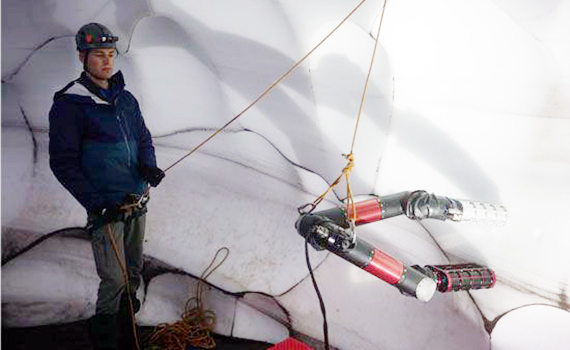
Specialists from the NASA laboratory created a unique IceWorm robot that, like a rockworm, can climb steep cliffs of ice and stone.
Despite the network of satellites and modern technology, there are still places on Earth that people simply cannot get to. A good example is Mount Erebus in Antarctica. It is the southernmost active volcano on earth and the second highest volcano on the continent. For scientists, this is nothing more than a potential “treasury” in which it will be possible with high probability to find traces of the DNA of ancient beings. But, alas, for people it is not available - the culprit is the high concentration of carbon dioxide in the tunnels.
This mountain and other similar places became one of the reasons that prompted NASA engineers to create the IceWorm (ice worm) robot. Extreme Environments Robotics from NASA's Jet Propulsion Laboratory has been working on this project since 2016. Aaron Curtis, the lead designer of IceWorm, studied all the information currently available on the Erebus volcano so that the robot could work effectively even in extreme conditions of gassed tunnels. Curtis was looking for robots that could move on the ice. And although JPL experts have already been involved in projects like the LEMUR rock-climbing robot, a suitable construction for overcoming the sheer walls of ice has not yet been created.
IceWorm got its name thanks to the method of movement. Its height is about 1.4 meters, and the bot itself fixes its position on the ice with two "legs", using steel screws - one limb always higher than the other.
Curtis notes that this model of movement for the robot is "completely new and unique." It is worth noting that the limbs of the robot are equipped with pressure sensors, which allows the machine to assess the surface and balance on ice. Iceworm has already been successfully tested in dangerous conditions - on Mount St. Helens in Washington state, where in 1980 there was a strong eruption.
The potential of such robots is extremely high. If IceWorm and similar bots can overcome ice cliffs and climb volcanoes, then all scientists, from geologists to biologists and meteorologists, will have a unique method of data mining not only on Earth, but also on other planets, and even in outer space. These robots are ideal for the study of frozen moons like Enceladus or Europe, covered with a thick layer of solid ice, from which sharp and smooth hummocks rise - in some places their height reaches 15 meters.





